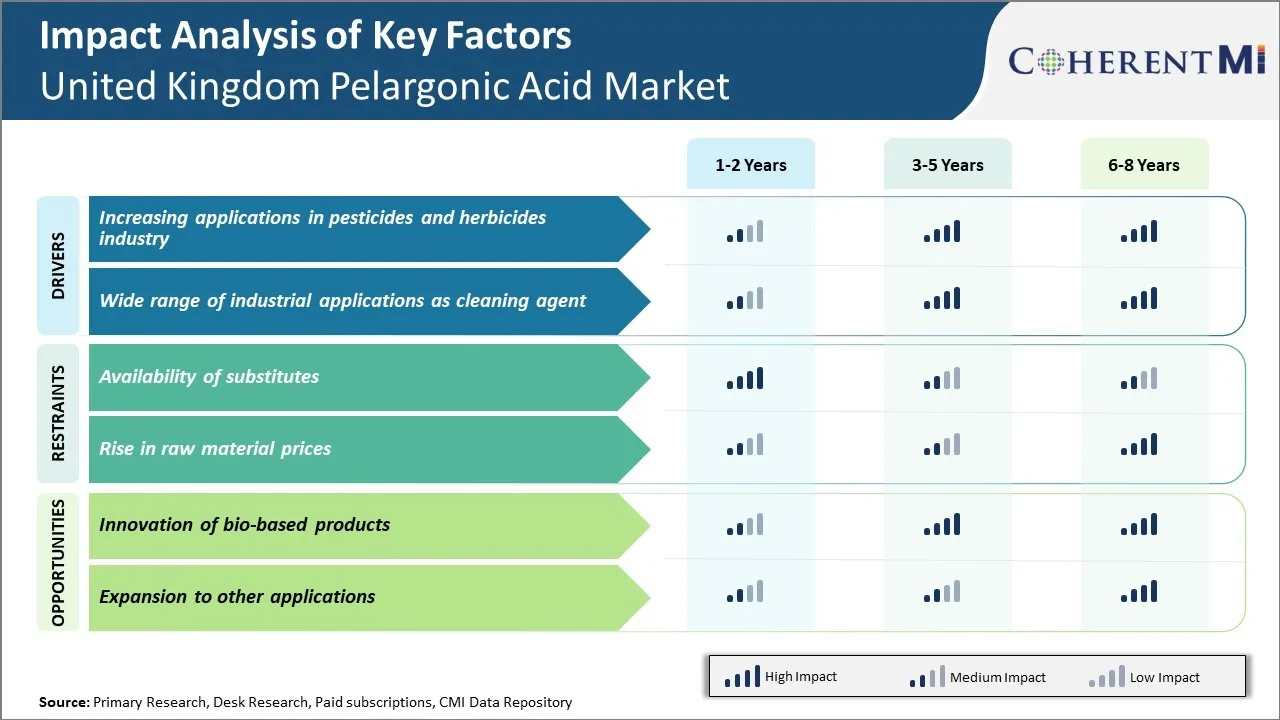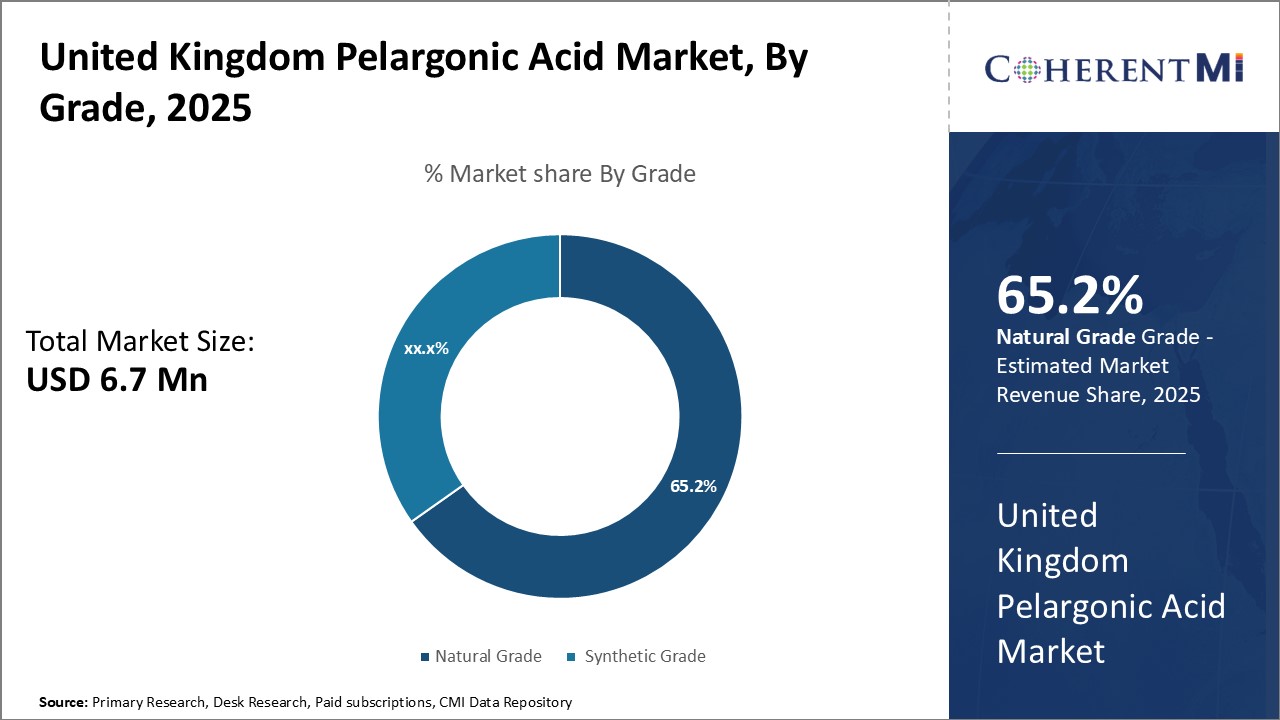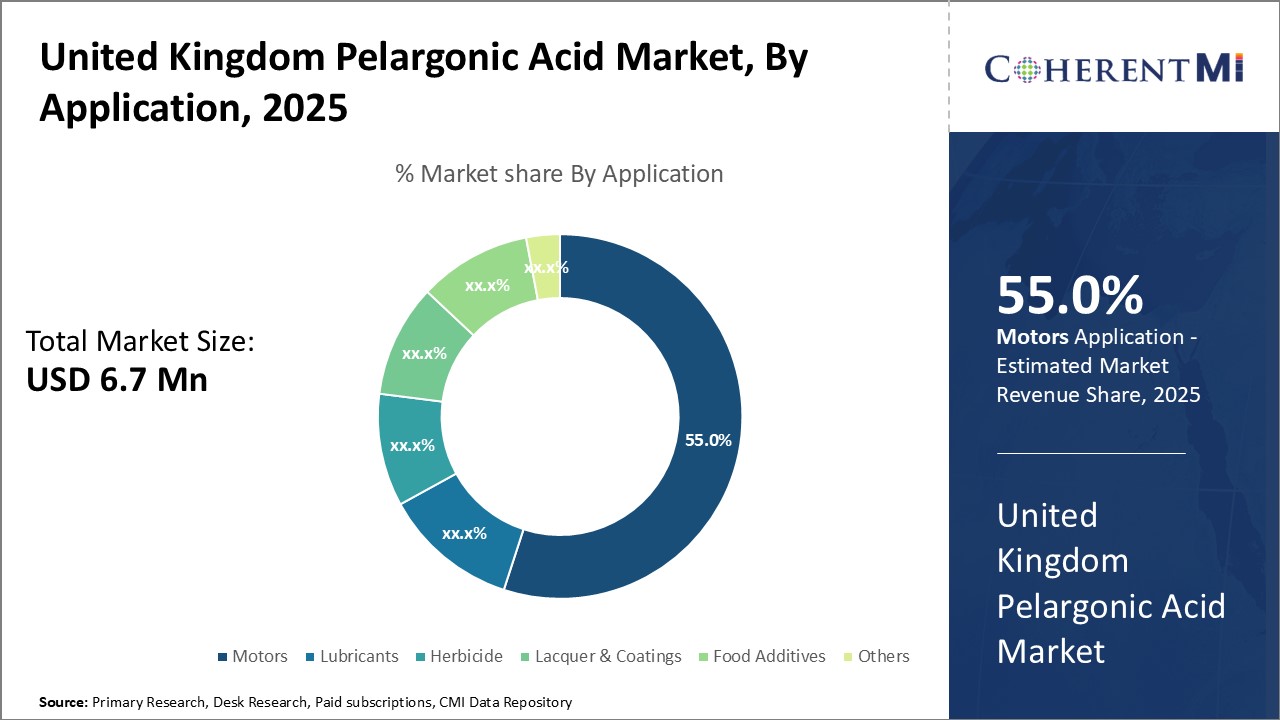United Kingdom Pelargonic Acid Market Size - Analysis
The United Kingdom Pelargonic Acid Market is estimated to be valued at USD 6.9 Mn in 2025 and is expected to reach USD 10.7 Mn by 2032, growing at a compound annual growth rate (CAGR) of 6.9% from 2025 to 2032.
Market Size in USD Mn
CAGR6.9%
| Study Period | 2025-2032 |
| Base Year of Estimation | 2024 |
| CAGR | 6.9% |
| Market Concentration | High |
| Major Players | Central Drug House. , Croda International Plc, Emery Oleochemicals UK Limited, Glentham Life Sciences Limited, OQ Chemicals GmbH and Among Others |
please let us know !
United Kingdom Pelargonic Acid Market Trends
The use of pelargonic acid in the production of pesticides and herbicides has been rising steadily over the past few years. As a natural fatty acid, it is finding increasing acceptance as a sustainable alternative to conventional synthetic pesticides. Pelargonic acid works by interfering with the fatty acid synthesis in insects and fungi, ultimately resulting in their death. However, being derived from natural sources, it breaks down rapidly in the environment without leaving persistent residues. This has helped pelargonic acid gain approvals for use in organic farming across Europe.
Going forward, the drive for sustainability and focus on strengthening soil health are expected to further boost the demand for natural biopesticides. With the commercial agriculture industry recognising its responsibility towards minimizing environmental footprints, pelargonic acid can find more applications across different systems of farming. Government schemes that incentivize sustainable practices may additionally support increased pelargonic acid consumption. While initial costs tend to be higher, farmers have reported pelargonic acid providing effective pest and disease control at par with synthetic chemicals, besides improving long-term soil quality. This could accelerate its acceptance in mainstream commercial agriculture over time.
Market Driver - Wide Scope in Industrial Cleaning
Food processing is another major area utilizing pelargonic acid cleaners. Approved for incidental food contact, it is used for sanitizing food processing lines, dairy equipment and surfaces in compliance with stringent hygiene standards. Hospitals and healthcare facilities too employ pelargonic acid-based disinfectants and detergents for cleaning, due to its rapid antimicrobial action and safety. Hotels, restaurants and other hospitality businesses source pelargonic acid cleaners for routine maintenance and deep cleaning of rooms, public restrooms and kitchen areas. Its versatility in hard surface cleaning across varied industries holds potential for continued demand upsurge.

The United Kingdom pelargonic acid market faces significant challenges from the availability of substitute products. Pelargonic acid has numerous applications as an emollient, surfactant, and antimicrobial agent in cosmetics, personal care, and other industrial products. However, alternative bio-based ingredients such as capric acid and caprylic acid can often fulfill the same roles as pelargonic acid. Capric acid and caprylic acid are shorter medium-chain fatty acids that share similar properties to pelargonic acid. Both are widely used in cosmetics and personal care formulations. They offer formulators flexibility in product design since they can replace pelargonic acid without significantly altering the end product. The widespread availability and lower prices of capric acid and caprylic acid relative to pelargonic acid threatens market share. For the pelargonic acid market to grow, suppliers must focus on developing unique value propositions that cannot be easily substituted or promote combined system approaches using pelargonic acid and its alternatives.
Market Opportunities: Innovation of bio-based products
Key winning strategies adopted by key players of United Kingdom Pelargonic Acid Market
Strategic partnerships and collaborations: Emery Oleochemicals formed a strategic partnership with INOLEX in 2017 to expand its production capabilities for pelargonic acid. This allowed Emery to meet the growing demand from personal care applications. Such partnerships help companies gain access to new technologies and markets.
Expansion of production capacities: Oleon increased its pelargonic acid production capacity at its plant in Feluy, Belgium by 20% in 2019. This enabled the company to strengthen supply reliability for customers in Europe. Capacity expansion ensures key players can capitalize on rising demand without supply constraints.
Segmental Analysis of United Kingdom Pelargonic Acid Market
 Insights by grade: Natural Properties Drive Demand for Natural Grade Pelargonic Acid
Insights by grade: Natural Properties Drive Demand for Natural Grade Pelargonic AcidIn terms of grade, natural grade pelargonic acid contributes the 65.20% share of the UK market in 2025 owing to strong demand from end users seeking natural ingredients. Pelargonic acid can be produced synthetically or derived from natural sources like palm kernel oil. However, natural grade pelargonic acid has unique properties that make it attractive compared to synthetic alternatives. Being derived from natural palm kernel oil gives natural grade pelargonic acid a perceived cleaner, purer composition that appeals to health-conscious consumers. This 'natural' image allows product formulators to market finished goods as containing 'natural ingredients' which has been shown to boost sales.
The combination of perceived purity, potential health halo, environmental preference and traceable sourcing underpins natural grade's leadership position in the UK pelargonic acid landscape. As consumers increasingly prioritize naturalness and sustainability, demand looks set to remain robust for natural grade pelargonic acid to serve diverse end uses.

Within pelargonic acid applications in the UK, the motors segment generates the 55.0% share in 2025. Pelargonic acid enjoys widespread use as a multi-functional additive for lubricating engine oils and other lubricants. Its surface-active properties allow it to perform crucial cleaning, corrosion protection and anti-wear functions when blended into lubricants at very low levels. As pelargonic acid safely improves lubricant performance, original equipment manufacturers increasingly specify it for use in high-precision engines across various industries.
Lubricated motors will continue occupying the number one slot for pelargonic acid applications locally. Its multi-purpose functionality delivers material cost savings that offset minimal additive levels used. As engine technology progresses, performance demands on lubricants will further propel pelargonic acid consumption through the motors segment for the foreseeable future.
Competitive overview of United Kingdom Pelargonic Acid Market
Central Drug House, Croda International Plc, Emery Oleochemicals UK Limited, Glentham Life Sciences Limited, OQ Chemicals GmbH
United Kingdom Pelargonic Acid Market Leaders
- Central Drug House.
- Croda International Plc
- Emery Oleochemicals UK Limited
- Glentham Life Sciences Limited
- OQ Chemicals GmbH
United Kingdom Pelargonic Acid Market - Competitive Rivalry

United Kingdom Pelargonic Acid Market
(Dominated by major players)
(Highly competitive with lots of players.)
Recent Developments in United Kingdom Pelargonic Acid Market
- On December 2021, Glentham Life Sciences Limited announced an expansion in its footprint by launching a new subsidiary for the EU. This expansion has allowed the company to expand its customer base and strengthen its leadership position in the markets of Germany and U.K.
United Kingdom Pelargonic Acid Market Segmentation
- By Grade
- Natural Grade
- Synthetic Grade
- By Application
- Motors
- Lubricants
- Herbicide
- Lacquer & Coatings
- Food Additives
- Others (Personal Care & Cosmetics, etc.)

Would you like to explore the option of buying individual sections of this report?
Yash Doshi is a Senior Management Consultant. He has 12+ years of experience in conducting research and handling consulting projects across verticals in APAC, EMEA, and the Americas.
He brings strong acumen in helping chemical companies navigate complex challenges and identify growth opportunities. He has deep expertise across the chemicals value chain, including commodity, specialty and fine chemicals, plastics and polymers, and petrochemicals. Yash is a sought-after speaker at industry conferences and contributes to various publications on topics related commodity, specialty and fine chemicals, plastics and polymers, and petrochemicals.
Frequently Asked Questions :
How big is the United Kingdom Pelargonic Acid Market?
The United Kingdom Pelargonic Acid Market is estimated to be valued at USD 6.7 in 2025 and is expected to reach USD 10.7 Million by 2032.
What are the major factors driving the United Kingdom Pelargonic Acid Market growth?
The increasing applications in pesticides and herbicides industry and wide range of industrial applications as cleaning agent are the major factor driving the United Kingdom Pelargonic Acid Market.
Which is the leading Grade in the United Kingdom Pelargonic Acid Market?
The leading Grade segment is Natural Grade .
Which are the major players operating in the United Kingdom Pelargonic Acid Market?
Croda Internional, Emery Oleochemicals UK Limited, Glentham Life Sciences Limited, OQ Chemicals GmbH, Matrica S.p.A, Thermo Scientific, Croda International Plc are the major players.
What will be the CAGR of the United Kingdom Pelargonic Acid Market?
The CAGR of the United Kingdom Pelargonic Acid Market is projected to be 6.9% from 2025-2032.